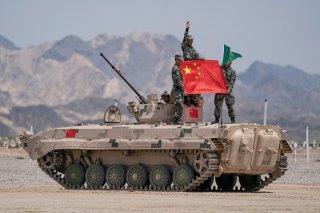7,000 and Counting: China Has the World's Largest Tank Force
Sorry, America.
Key Point: Quantity does not equal quality.
In 2019 both the U.S. and Russian armies introduced new versions of their primary main battle tank, helping to enhance what is widely viewed as the world’s leading armored forces.
But China, not the United States or Russia, possesses the planet’s biggest tank force, all-together possessing a whopping 6,900 tanks.
By contrast, the U.S. and Russian armies each need just under 2,000 tanks to fully equip all front-line armored units, although to be fair both armies also keep thousands of additional tanks in reserve.
At present, old and obsolete tanks comprise roughly half of the Chinese inventory. But the mix of tanks in the People’s Liberation Army is changing fast as Beijing develops new models and buys them in bulk.
Which is not to say the PLA knows how to use all these new vehicles. When it comes to tanks, China’s doctrine lags behind its equipment.
“Although Russia and the United States both maintain substantial numbers of main battle tanks in store, China’s People’s Liberation Army currently has the world’s largest active-service tank fleet,” the London-based International Institute for Strategic Studies explained in 2018.
“The volume and cost involved in producing sufficient modern tank designs to equip this force has, however, proved to be a significant challenge for the PLA, and it is only recently that the percentage of the tank force so-equipped has risen above 50 percent.”
The PLA possesses five main tank models.
The Type 59 is a license-built Russian T-54 that China produced from 1958 to 1978. The Type 59 features a 100-millimeter smoothbore or 105-millimeter rifled cannon and steel armor. Type 59s account for around 2,900 of China’s 6,900 active tanks.
These older tanks are “effectively obsolete,” according to IISS. It’s unlikely they would play a meaningful role in a high-intensity conflict.
The Type 79, which China produced in the late 1970s and early 1980s, has a 105-millimeter rifled gun and steel armor. The similar Type 88, in production in the late 1980s and 1990s, adds a stabilized sight.
There are around 500 Type 79s and Type 88s in PLA service. IISS claimed the Type 79s and 88s equip just a handful of units in China’s mountainous northern and western regions.
The Type 96, in production from 1997 to 2005, boasts a 125-millimeter smoothbore gun, composite armored and stabilized sights. The Type 99, currently in production, adds reactive armor and modern computer systems.
The PLA has around 3,400 Type 96s and 99s. IISS predicted the Chinese army might remove from service all pre-1997 tanks and equip a smaller number of combined-arms units exclusively with Type 96s and 99s.
But the PLA will need doctrine to match the more modern equipment. With zero recent combat experience, the PLA's tactics and training in some cases are inadequate, Global Times reported. The government-run news organization cited an army war game as one example.
"As training began in 2019, an elite-combined arms brigade under the 81st Group Army of the People's Liberation Army Central Theater Command reflected how they failed to beat its opponent in a 2018 mock battle, despite being equipped with China's strongest main battle tank, the Type 99A," Global Times reported, citing the state-run CCTV television news network.
"Although the mock battle took place in July 2018 at the Zhurihe training base, Inner Mongolia Autonomous Region, it was the first time that the details of the exercise were revealed," Global Times continued.
"The Type 99A units are digitized and interconnected, and are capable of striking enemies even beyond visual range. However, the elite brigade was heavily suppressed during the exercise because of obsolete ways of thinking, the CCTV report said."
"We rushed with the Type 99A too close to the frontline, which did not optimize the use of the tank's combat capability," CCTV quoted Xu Chengbiao, a battalion commander in the brigade, as saying.
Equipping an army with modern tanks is one thing. As the PLA is learning, effectively using the same tanks is entirely another thing. "We only studied the capabilities of older tanks, but have not completely understood new ones," Zhao Jianxin, another battalion commander, reportedly told CCTV.
David Axe was the Defense Editor of the National Interest. He is the author of the graphic novels War Fix, War Is Boring and Machete Squad. This article first appeared in 2019.
Image: Reuters

